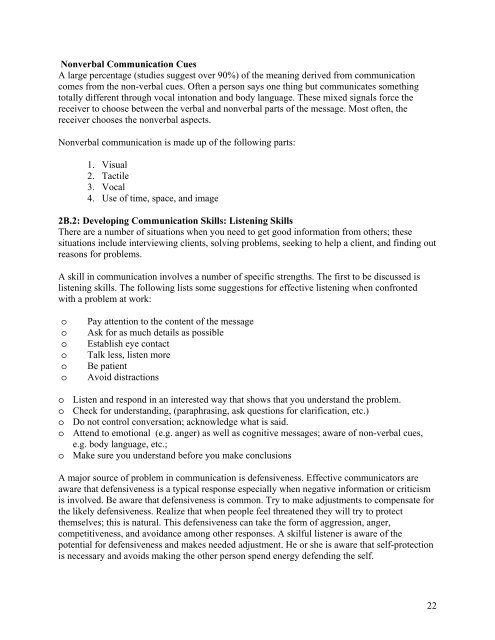Training Manual for Preventive Malaria - Ministry of Health
Training Manual for Preventive Malaria - Ministry of Health
Training Manual for Preventive Malaria - Ministry of Health
You also want an ePaper? Increase the reach of your titles
YUMPU automatically turns print PDFs into web optimized ePapers that Google loves.
Nonverbal Communication Cues<br />
A large percentage (studies suggest over 90%) <strong>of</strong> the meaning derived from communication<br />
comes from the non-verbal cues. Often a person says one thing but communicates something<br />
totally different through vocal intonation and body language. These mixed signals <strong>for</strong>ce the<br />
receiver to choose between the verbal and nonverbal parts <strong>of</strong> the message. Most <strong>of</strong>ten, the<br />
receiver chooses the nonverbal aspects.<br />
Nonverbal communication is made up <strong>of</strong> the following parts:<br />
1. Visual<br />
2. Tactile<br />
3. Vocal<br />
4. Use <strong>of</strong> time, space, and image<br />
2B.2: Developing Communication Skills: Listening Skills<br />
There are a number <strong>of</strong> situations when you need to get good in<strong>for</strong>mation from others; these<br />
situations include interviewing clients, solving problems, seeking to help a client, and finding out<br />
reasons <strong>for</strong> problems.<br />
A skill in communication involves a number <strong>of</strong> specific strengths. The first to be discussed is<br />
listening skills. The following lists some suggestions <strong>for</strong> effective listening when confronted<br />
with a problem at work:<br />
o<br />
o<br />
o<br />
o<br />
o<br />
o<br />
Pay attention to the content <strong>of</strong> the message<br />
Ask <strong>for</strong> as much details as possible<br />
Establish eye contact<br />
Talk less, listen more<br />
Be patient<br />
Avoid distractions<br />
o Listen and respond in an interested way that shows that you understand the problem.<br />
o Check <strong>for</strong> understanding, (paraphrasing, ask questions <strong>for</strong> clarification, etc.)<br />
o Do not control conversation; acknowledge what is said.<br />
o Attend to emotional (e.g. anger) as well as cognitive messages; aware <strong>of</strong> non-verbal cues,<br />
e.g. body language, etc.;<br />
o Make sure you understand be<strong>for</strong>e you make conclusions<br />
A major source <strong>of</strong> problem in communication is defensiveness. Effective communicators are<br />
aware that defensiveness is a typical response especially when negative in<strong>for</strong>mation or criticism<br />
is involved. Be aware that defensiveness is common. Try to make adjustments to compensate <strong>for</strong><br />
the likely defensiveness. Realize that when people feel threatened they will try to protect<br />
themselves; this is natural. This defensiveness can take the <strong>for</strong>m <strong>of</strong> aggression, anger,<br />
competitiveness, and avoidance among other responses. A skilful listener is aware <strong>of</strong> the<br />
potential <strong>for</strong> defensiveness and makes needed adjustment. He or she is aware that self-protection<br />
is necessary and avoids making the other person spend energy defending the self.<br />
22















